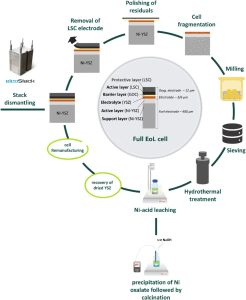Hydrogen technologies are considered one of the key pathways to decarbonizing the economy and significantly contribute to achieving the European Union’s sustainability goals. As the use of hydrogen fuel cells rapidly increases, it becomes increasingly important to consider what happens to them at the end of their lifecycle. For a sustainable future, we must develop solutions that enable efficient recycling, reduce environmental impact, and reuse valuable materials.
This requires a holistic approach: evaluating the impacts of different recycling processes using Life Cycle Assessment (LCA) methodology, developing efficient and environmentally friendly recycling methods, and implementing policies such as eco-design and extended producer responsibility that ensure responsible management of devices throughout their entire lifecycle.
Solid oxide cells (SOC) are advanced devices capable of producing electricity or hydrogen—depending on their mode of operation. As solid oxide fuel cells (SOFC), they generate electric power; as solid oxide electrolysis cells (SOEC), they enable hydrogen production. Although this technology is still under development, it holds significant potential for the future hydrogen economy. Its main advantages include high efficiency, flexibility, potential for thermal integration with other systems, and the ability to operate bidirectionally—as an energy source or storage medium.

As the use of these cells is expected to grow rapidly in the future, it is important to consider their sustainability now. This means understanding their entire lifecycle—from production to end-of-use—and developing effective recycling methods and ways to reuse valuable materials.
These cells contain rare and critical metals such as cobalt, lanthanum, yttrium, and nickel, most of which are imported into the EU. Therefore, the European Union aims to reduce import dependency by seeking substitutes, optimizing the use of these raw materials, and improving recycling processes. However, current data on handling these cells at the end of their life is still lacking, which means more research and development of technologies for their efficient processing and reuse is needed.
The scientific paper titled “New life cycle inventories for end-of-life solid oxide cells based on novel recycling processes for critical solid oxide cell materials” presents part of the results from the EU-funded project BEST4Hy. It focuses on LCA evaluation by researchers from the Laboratory for Heat and Power (LTE) at the Faculty of Mechanical Engineering and recycling process implementations by researchers from the Polytechnic University of Turin.
The study introduces a new approach to assess the impacts of recycling materials from solid oxide fuel cells (SOC). Since industrial-scale recycling processes for these cells are not yet available, past research has largely excluded them. This analysis is based on laboratory experiments and provides valuable data on procedures for reclaiming critical materials such as zirconium and nickel. Additionally, it presents new methods for recycling metals like lanthanum and cobalt in detail for the first time, significantly enhancing existing research on the sustainable use of rare raw materials.
The paper is published in the International Journal of Hydrogen Energy, which has an impact factor of 8.1, placing it in the top quartile and marking a remarkable scientific achievement in this field. The full article is available at the provided link.


